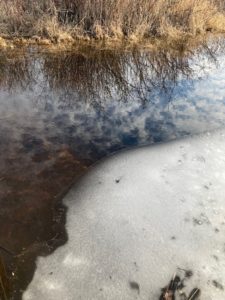 We’re now in the third full week of March. This has always been a significant time for me, one who grew up along the banks of the Manitowoc River. My grandparents purchased an old farmstead and 40 acres near Rapids, and I had the luxury of occupying my childhood with walking, swimming, fishing, fort-building, and all the other things kids do, or used to do, on a daily basis.
We’re now in the third full week of March. This has always been a significant time for me, one who grew up along the banks of the Manitowoc River. My grandparents purchased an old farmstead and 40 acres near Rapids, and I had the luxury of occupying my childhood with walking, swimming, fishing, fort-building, and all the other things kids do, or used to do, on a daily basis. My grandfather loved to journal, mostly about weather, and hunting and fishing. He fished area rivers and lakes, trout streams up north, and hunted small game far and wide. He camped frequently in his early years, but that was always accompanied by hunting and fishing. In fall, he trapped muskrats to earn money for Christmas presents for the family. His journals are filled with narratives of such trips. But one of the most important aspects of his seasonal notations was ice-out on the river.
To our family, ice-out was truly a sign of spring. It was preceded by the ice, which we had skated on just a few weeks before, rotting as it thawed. It was accompanied by general snow melt and subsequent rising of the water, which pushed ice up in the middle, but it still clung to the banks. There, along shore the brown water rose above the mantel, which prevented curious young people from venturing out past the point where it was safe. Chunks would break off and thump their way downstream beneath the ice, and later, finally, the whole mass, or most of it, would slough off and move downstream. As it did, it made a hissing or scraping sound, with occasional thumps as pieces bumped on rocks or shore. Sometimes, it became jammed, especially at Rapids not far downstream. Then, the water would rise even more, sometimes carrying floes up onto our lawn and up to the house. Then, suddenly, it was gone, the river flowing wildly in its wake. Even though it was open now, it was far too high and fast for fishing- we’d have to wait weeks for that.
The average for ice-out, after compiling decades of those dates, was the third week in March. I remember walking along the river after ice out, hearing red-winged blackbirds and seeing mallards, goldeneyes (whistlers), mergansers (fish ducks), and buffleheads. There weren’t as many geese as now, nor bald eagles which we now see daily cruising the open river.
At the same time the land along the river, seemingly wakened by the change in the river, also burst into new life. Buds or soft maples and lilacs swelling, woodcock dancing in the evening, song sparrows singing in the morning, followed by frogs in a few weeks, about the time the smelt and suckers ran in the river.
This year, the river was fickle. I still live in the same place, but the river is now un-dammed and back to its original level, faster flowing and never good for skating even in the coldest weather. This year it froze and thawed at intervals, and never seemed safe to walk on. Ice began to leave at the beginning of March, and the first half of the month it was only partially frozen. Then the ice was completely gone during the second full week, around St. Patrick’s day. This year was definitely earlier than my grandpa’s average, but it is hard to say when ice-out actually occurred. But, it’s a different world now, with our winter temps barely dipping below zero at all. It still lasts as long, though.
Winter is a wonderful time of year, but this early, muddy season is still special to me. When I walk along the West Twin at Woodland Dunes, the feeling is the same- with the addition of lots of geese and some sandhill cranes. The swamp is flooded, but skunk cabbage blooms are peeking above the water and snow. Each day reveals something new for the year. It’s still a great time to explore.
photo- melting ice on David’s pond at Woodland Dunes by Nancy Nabak
